#open-source API testing tools
Explore tagged Tumblr posts
Text
Harnessing the Power of Open Source API Testing

Introduction
In the ever-evolving landscape of software development, ensuring the reliability and functionality of APIs (Application Programming Interfaces) is crucial. APIs serve as the bridge between different software components, enabling them to communicate and interact seamlessly. To ensure that these APIs perform as expected, API testing is essential. Open source API testing tools have gained popularity as cost-effective and flexible solutions for developers and testers alike. In this article, we'll explore the significance of open source API testing, its benefits, and some of the most popular tools available today.
The Importance of API Testing
APIs are the backbone of modern software applications. They facilitate data exchange, allow different systems to work together, and enable third-party integrations. Ensuring the quality and reliability of APIs is paramount to avoid system failures, security breaches, and poor user experiences. Here are some key reasons why API testing is crucial:
Functionality Testing: API testing verifies that the API performs its intended functions correctly. It ensures that the data inputs and outputs are accurate and adhere to the API's specifications.
Security: Security vulnerabilities in APIs can have severe consequences. API testing helps identify and mitigate potential security risks, such as unauthorized access or data leaks.
Performance: Poorly performing APIs can slow down applications or even lead to outages. API testing assesses an API's performance under various conditions to ensure it can handle expected levels of traffic.
Compatibility: APIs are used across different platforms and devices. Testing ensures that the API works consistently across various environments and devices.
Documentation: Testing helps validate and improve API documentation, making it easier for developers to understand and use the API.
Open Source API Testing: Advantages
Open source API testing tools offer numerous advantages that make them appealing for developers and organizations:
Cost-Effective: Open source tools are typically free to use, making them a budget-friendly choice for both small startups and large enterprises.
Community Support: These tools often have active and engaged communities of developers who contribute to their improvement and provide support through forums and documentation.
Flexibility: Open source tools can be customized to suit specific testing requirements, allowing testers to adapt them to their unique needs.
Transparency: Users have access to the source code, which enhances transparency and trust in the tool's functionality and security.
Wide Adoption: Many open source API testing tools have gained wide adoption in the industry, making them well-tested and reliable choices.
Popular Open Source API Testing Tools
Keploy: Keploy is an AI-powered testing tool that specializes in creating test cases and generating stubs/mocks for end-to-end testing. It can achieve an impressive 90% test coverage in just a matter of minutes using open-source testing resources. Keploy offers several notable features, including a straightforward Integration Framework for incorporating new libraries, the ability to convert API calls into test cases and data mocks, and the capability to handle a wide range of detailed test cases. Additionally, it supports four programming languages: Java, Node.js, Python, and Go.
Postman: Postman is one of the most well-known API testing tools. It offers a user-friendly interface for creating and running API tests, as well as features for automating tests and generating documentation.
Swagger (OpenAPI): Swagger, now known as OpenAPI, provides a framework for designing, building, and documenting APIs. It includes tools for testing APIs based on their specifications.
REST Assured: REST Assured is a Java library for testing RESTful APIs. It simplifies API testing by providing a domain-specific language for writing tests.
SoapUI: While SoapUI is primarily known for testing SOAP-based web services, it also supports RESTful APIs. It offers both open source and commercial versions.
Karate: Karate is a unique open source API testing tool that combines API testing with behavior-driven development (BDD). It allows testers to write API tests in a natural language style.
Conclusion
Open source API testing tools have become essential assets for software development teams aiming to build reliable and robust APIs. Their cost-effectiveness, flexibility, and strong community support make them an attractive choice for organizations of all sizes. As APIs continue to play a pivotal role in modern software development, investing in open source API testing tools can help ensure the success of your projects while saving both time and money. Whether you are testing RESTful or SOAP-based APIs, there is likely an open source tool that suits your needs, enabling you to create and maintain APIs that perform flawlessly in today's interconnected digital world.
0 notes
Text

API (Application Programming Interface) testing is a type of software testing that aims to determine whether the applications are error-free or not.
#api testing tools#api testing tools online#api testing tools open source#api testing tools free#api testing tools paid#pro version api tool#what is api
1 note
·
View note
Text
Elon Musk’s so-called Department of Government Efficiency (DOGE) used artificial intelligence from Meta’s Llama model to comb through and analyze emails from federal workers.
Materials viewed by WIRED show that DOGE affiliates within the Office of Personnel Management (OPM) tested and used Meta’s Llama 2 model to review and classify responses from federal workers to the infamous “Fork in the Road” email that was sent across the government in late January.
The email offered deferred resignation to anyone opposed to changes the Trump administration was making to its federal workforce, including an enforced return-to-office policy, downsizing, and a requirement to be “loyal.” To leave their position, recipients merely needed to reply with the word “resign.” This email closely mirrored one that Musk sent to Twitter employees shortly after he took over the company in 2022.
Records show that Llama was deployed to sort through email responses from federal workers to determine how many accepted the offer. The model appears to have run locally, according to materials viewed by WIRED, meaning it’s unlikely to have sent data over the internet.
Meta and OPM did not respond to requests for comment from WIRED.
Meta CEO Mark Zuckerberg appeared alongside other Silicon Valley tech leaders like Musk and Amazon founder Jeff Bezos at Trump’s inauguration in January, but little has been publicly known about his company’s tech being used in government. Because of Llama’s open-source nature, the tool can easily be used by the government to support Musk’s goals without the company’s explicit consent.
Soon after Trump took office in January, DOGE operatives burrowed into OPM, an independent agency that essentially serves as the human resources department for the federal government. The new administration’s first big goal for the agency was to create a government-wide email service, according to current and former OPM employees. Riccardo Biasini, a former Tesla engineer, was involved in building the infrastructure for the service that would send out the original “Fork in the Road” email, according to material viewed by WIRED and reviewed by two government tech workers.
In late February, weeks after the Fork email, OPM sent out another request to all government workers and asked them to submit five bullet points outlining what they accomplished each week. These emails threw a number of agencies into chaos, with workers unsure how to manage email responses that had to be mindful of security clearances and sensitive information. (Adding to the confusion, it has been reported that some workers who turned on read receipts say they found that the responses weren’t actually being opened.) In February, NBC News reported that these emails were expected to go into an AI system for analysis. While the materials seen by WIRED do not explicitly show DOGE affiliates analyzing these weekly “five points” emails with Meta’s Llama models, the way they did with the Fork emails, it wouldn’t be difficult for them to do so, two federal workers tell WIRED.
“We don’t know for sure,” says one federal worker on whether DOGE used Meta’s Llama to review the “five points” emails. “Though if they were smart they’d reuse their code.”
DOGE did not appear to use Musk’s own AI model, Grok, when it set out to build the government-wide email system in the first few weeks of the Trump administration. At the time, Grok was a proprietary model belonging to xAI, and access to its API was limited. But earlier this week, Microsoft announced that it would begin hosting xAi’s Grok 3 models as options in its Azure AI Foundry, making the xAI models more accessible in Microsoft environments like the one used at OPM. This potentially, should they want it, would enable Grok as an option as an AI system going forward. In February, Palantir struck a deal to include Grok as an AI option in the company’s software, which is frequently used in government.
Over the past few months, DOGE has rolled out and used a variety of AI-based tools at government agencies. In March, WIRED reported that the US Army was using a tool called CamoGPT to remove DEI-related language from training materials. The General Services Administration rolled out “GSAi” earlier this year, a chatbot aimed at boosting overall agency productivity. OPM has also accessed software called AutoRIF that could assist in the mass firing of federal workers.
4 notes
·
View notes
Text
This Week in Rust 599
Hello and welcome to another issue of This Week in Rust! Rust is a programming language empowering everyone to build reliable and efficient software. This is a weekly summary of its progress and community. Want something mentioned? Tag us at @thisweekinrust.bsky.social on Bluesky or @ThisWeekinRust on mastodon.social, or send us a pull request. Want to get involved? We love contributions.
This Week in Rust is openly developed on GitHub and archives can be viewed at this-week-in-rust.org. If you find any errors in this week's issue, please submit a PR.
Want TWIR in your inbox? Subscribe here.
Updates from Rust Community
Official
Announcing Google Summer of Code 2025 selected projects
Foundation
10 Years of Stable Rust: An Infrastructure Story
Newsletters
This Month in Rust OSDev: April 2025 | Rust OSDev
The Embedded Rustacean Issue #45
Project/Tooling Updates
Avian Physics 0.3
Two months in Servo: CSS nesting, Shadow DOM, Clipboard API, and more
Cot v0.3: Even Lazier
Streaming data analytics, Fluvio 0.17.3 release
CGP v0.4 is Here: Unlocking Easier Debugging, Extensible Presets, and More
Rama v0.2
Observations/Thoughts
Bad Type Patterns - The Duplicate duck
Rust nightly features you should watch out for
Lock-Free Rust: How to Build a Rollercoaster While It’s on Fire
Simple & type-safe localization in Rust
From Rust to AVR assembly: Dissecting a minimal blinky program
Tarpaulins Week Of Speed
Rustls Server-Side Performance
Is Rust the Future of Programming?
Rust Walkthroughs
Functional asynchronous Rust
The Power of Compile-Time ECS Architecture in Rust
[video] Build with Naz : Spinner animation, lock contention, Ctrl+C handling for TUI and CLI
Miscellaneous
April 2025 Rust Jobs Report
Crate of the Week
This week's crate is brush, a bash compatible shell implemented completely in Rust.
Thanks to Josh Triplett for the suggestion!
Please submit your suggestions and votes for next week!
Calls for Testing
An important step for RFC implementation is for people to experiment with the implementation and give feedback, especially before stabilization.
If you are a feature implementer and would like your RFC to appear in this list, add a call-for-testing label to your RFC along with a comment providing testing instructions and/or guidance on which aspect(s) of the feature need testing.
No calls for testing were issued this week by Rust, Rust language RFCs or Rustup.
Let us know if you would like your feature to be tracked as a part of this list.
RFCs
Rust
Rustup
If you are a feature implementer and would like your RFC to appear on the above list, add the new call-for-testing label to your RFC along with a comment providing testing instructions and/or guidance on which aspect(s) of the feature need testing.
Call for Participation; projects and speakers
CFP - Projects
Always wanted to contribute to open-source projects but did not know where to start? Every week we highlight some tasks from the Rust community for you to pick and get started!
Some of these tasks may also have mentors available, visit the task page for more information.
rama - add ffi/rama-rhai: support ability to use services and layers written in rhai
rama - support akamai h2 passive fingerprint and expose in echo + fp services
If you are a Rust project owner and are looking for contributors, please submit tasks here or through a PR to TWiR or by reaching out on X (formerly Twitter) or Mastodon!
CFP - Events
Are you a new or experienced speaker looking for a place to share something cool? This section highlights events that are being planned and are accepting submissions to join their event as a speaker.
No Calls for papers or presentations were submitted this week.
If you are an event organizer hoping to expand the reach of your event, please submit a link to the website through a PR to TWiR or by reaching out on X (formerly Twitter) or Mastodon!
Updates from the Rust Project
397 pull requests were merged in the last week
Compiler
async drop fix for async_drop_in_place<T> layout for unspecified T
better error message for late/early lifetime param mismatch
perf: make the assertion in Ident::new debug-only
perf: merge typeck loop with static/const item eval loop
Library
implement (part of) ACP 429: add DerefMut to Lazy[Cell/Lock]
implement VecDeque::truncate_front()
Cargo
network: use Retry-After header for HTTP 429 responses
rustc: Don't panic on unknown bins
add glob pattern support for known_hosts
add support for -Zembed-metadata
fix tracking issue template link
make cargo script ignore workspaces
Rustdoc
rustdoc-json: remove newlines from attributes
ensure that temporary doctest folder is correctly removed even if doctests failed
Clippy
clippy: item_name_repetitions: exclude enum variants with identical path components
clippy: return_and_then: only lint returning expressions
clippy: unwrap_used, expect_used: accept macro result as receiver
clippy: add allow_unused config to missing_docs_in_private_items
clippy: add new confusing_method_to_numeric_cast lint
clippy: add new lint: cloned_ref_to_slice_refs
clippy: fix ICE in missing_const_for_fn
clippy: fix integer_division false negative for NonZero denominators
clippy: fix manual_let_else false negative when diverges on simple enum variant
clippy: fix unnecessary_unwrap emitted twice in closure
clippy: fix diagnostic paths printed by dogfood test
clippy: fix false negative for unnecessary_unwrap
clippy: make let_with_type_underscore help message into a suggestion
clippy: resolve through local re-exports in lookup_path
Rust-Analyzer
fix postfix snippets duplicating derefs
resolve doc path from parent module if outer comments exist on module
still complete parentheses & method call arguments if there are existing parentheses, but they are after a newline
Rust Compiler Performance Triage
Lot of changes this week. Overall result is positive, with one large win in type check.
Triage done by @panstromek. Revision range: 62c5f58f..718ddf66
Summary:
(instructions:u) mean range count Regressions ❌ (primary) 0.5% [0.2%, 1.4%] 113 Regressions ❌ (secondary) 0.5% [0.1%, 1.5%] 54 Improvements ✅ (primary) -2.5% [-22.5%, -0.3%] 45 Improvements ✅ (secondary) -0.9% [-2.3%, -0.2%] 10 All ❌✅ (primary) -0.3% [-22.5%, 1.4%] 158
Full report here
Approved RFCs
Changes to Rust follow the Rust RFC (request for comments) process. These are the RFCs that were approved for implementation this week:
No RFCs were approved this week.
Final Comment Period
Every week, the team announces the 'final comment period' for RFCs and key PRs which are reaching a decision. Express your opinions now.
Tracking Issues & PRs
Rust
Tracking Issue for non_null_from_ref
Add std::io::Seek instance for std::io::Take
aarch64-softfloat: forbid enabling the neon target feature
Stabilize the avx512 target features
make std::intrinsics functions actually be intrinsics
Error on recursive opaque ty in HIR typeck
Remove i128 and u128 from improper_ctypes_definitions
Guarantee behavior of transmuting Option::<T>::None subject to NPO
Temporary lifetime extension through tuple struct and tuple variant constructors
Stabilize tcp_quickack
Change the desugaring of assert! for better error output
Make well-formedness predicates no longer coinductive
No Items entered Final Comment Period this week for Cargo, Rust RFCs, Language Reference, Language Team or Unsafe Code Guidelines.
Let us know if you would like your PRs, Tracking Issues or RFCs to be tracked as a part of this list.
New and Updated RFCs
RFC: Extended Standard Library (ESL)
Upcoming Events
Rusty Events between 2025-05-14 - 2025-06-11 🦀
Virtual
2025-05-15 | Hybrid (Redmond, WA, US) | Seattle Rust User Group
May, 2025 SRUG (Seattle Rust User Group) Meetup
2025-05-15 | Virtual (Girona, ES) | Rust Girona
Sessió setmanal de codificació / Weekly coding session
2025-05-15 | Virtual (Joint Meetup, Europe + Israel) | Rust Berlin + Rust Paris + London Rust Project Group + Rust Zürisee + Rust TLV + Rust Nürnberg + Rust Munich + Rust Aarhus + lunch.rs
🦀 Celebrating 10 years of Rust 1.0 🦀
2025-05-15 | Virtual (Zürich, CH) | Rust Zürisee
🦀 Celebrating 10 years of Rust 1.0 (co-event with berline.rs) 🦀
2025-05-18 | Virtual (Dallas, TX, US) | Dallas Rust User Meetup
Rust Readers Discord Discussion: Async Rust
2025-05-19 | Virtual (Tel Aviv-yafo, IL) | Rust 🦀 TLV
Tauri: Cross-Platform desktop applications with Rust and web technologies
2025-05-20 | Hybrid (EU/UK) | Rust and C++ Dragons (former Cardiff)
Talk and Connect - Fullstack - with Goetz Markgraf and Ben Wishovich
2025-05-20 | Virtual (London, UK) | Women in Rust
Threading through lifetimes of borrowing - the Rust way
2025-05-20 | Virtual (Tel Aviv, IL) | Code Mavens 🦀 - 🐍 - 🐪
Rust at Work a conversation with Ran Reichman Co-Founder & CEO of Flarion
2025-05-20 | Virtual (Washington, DC, US) | Rust DC
Mid-month Rustful
2025-05-21 | Hybrid (Vancouver, BC, CA) | Vancouver Rust
Linking
2025-05-22 | Virtual (Berlin, DE) | Rust Berlin
Rust Hack and Learn
2025-05-22 | Virtual (Girona, ES) | Rust Girona
Sessió setmanal de codificació / Weekly coding session
2025-05-25 | Virtual (Dallas, TX, US) | Dallas Rust User Meetup
Rust Readers Discord Discussion: Async Rust
2025-05-27 | Virtual (Dallas, TX, US) | Dallas Rust User Meetup
Fourth Tuesday
2025-05-27 | Virtual (Tel Aviv, IL) | Code Mavens 🦀 - 🐍 - 🐪
Rust at Work - conversation with Eli Shalom & Igal Tabachnik of Eureka Labs
2025-05-29 | Virtual (Nürnberg, DE) | Rust Nuremberg
Rust Nürnberg online
2025-05-29 | Virtual (Tel Aviv-yafo, IL) | Rust 🦀 TLV
שיחה חופשית ווירטואלית על ראסט
2025-06-01 | Virtual (Dallas, TX, US) | Dallas Rust User Meetup
Rust Readers Discord Discussion: Async Rust
2025-06-03 | Virtual (Tel Aviv-yafo, IL) | Rust 🦀 TLV
Why Rust? למה ראסט? -
2025-06-04 | Virtual (Indianapolis, IN, US) | Indy Rust
Indy.rs - with Social Distancing
2025-06-05 | Virtual (Berlin, DE) | Rust Berlin
Rust Hack and Learn
2025-06-07 | Virtual (Kampala, UG) | Rust Circle Meetup
Rust Circle Meetup
2025-06-08 | Virtual (Dallas, TX, US) | Dallas Rust User Meetup
Rust Readers Discord Discussion: Async Rust
2025-06-10 | Virtual (Dallas, TX, US) | Dallas Rust User Meetup
Second Tuesday
2025-06-10 | Virtual (London, UK) | Women in Rust
👋 Community Catch Up
Asia
2025-05-17 | Delhi, IN | Rust Delhi
Rust Delhi Meetup #10
2025-05-24 | Bangalore/Bengaluru, IN | Rust Bangalore
May 2025 Rustacean meetup
2025-06-08 | Tel Aviv-yafo, IL | Rust 🦀 TLV
In person Rust June 2025 at AWS in Tel Aviv
Europe
2025-05-13 - 2025-05-17 | Utrecht, NL | Rust NL
RustWeek 2025
2025-05-14 | Reading, UK | Reading Rust Workshop
Reading Rust Meetup
2025-05-15 | Berlin, DE | Rust Berlin
10 years anniversary of Rust 1.0
2025-05-15 | Oslo, NO | Rust Oslo
Rust 10-year anniversary @ Appear
2025-05-16 | Amsterdam, NL | RustNL
Rust Week Hackathon
2025-05-16 | Utrecht, NL | Rust NL Meetup Group
RustWeek Hackathon
2025-05-17 | Amsterdam, NL | RustNL
Walking Tour around Utrecht - Saturday
2025-05-20 | Dortmund, DE | Rust Dortmund
Talk and Connect - Fullstack - with Goetz Markgraf and Ben Wishovich
2025-05-20 | Aarhus, DK | Rust Aarhus
Hack Night - Robot Edition
2025-05-20 | Leipzig, SN, DE | Rust - Modern Systems Programming in Leipzig
Topic TBD
2025-05-22 | Augsburg, DE | Rust Augsburg
Rust meetup #13:A Practical Guide to Telemetry in Rust
2025-05-22 | Bern, CH | Rust Bern
2025 Rust Talks Bern #3 @zentroom
2025-05-22 | Paris, FR | Rust Paris
Rust meetup #77
2025-05-22 | Stockholm, SE | Stockholm Rust
Rust Meetup @UXStream
2025-05-27 | Basel, CH | Rust Basel
Rust Meetup #11 @ Letsboot Basel
2025-05-27 | Vienna, AT | Rust Vienna
Rust Vienna - May at Bitcredit 🦀
2025-05-29 | Oslo, NO | Rust Oslo
Rust Hack'n'Learn at Kampen Bistro
2025-05-31 | Stockholm, SE | Stockholm Rust
Ferris' Fika Forum #12
2025-06-04 | Ghent, BE | Systems Programming Ghent
Grow smarter with embedded Rust
2025-06-04 | München, DE | Rust Munich
Rust Munich 2025 / 2 - Hacking Evening
2025-06-04 | Oxford, UK | Oxford Rust Meetup Group
Oxford Rust and C++ social
2025-06-05 | München, DE | Rust Munich
Rust Munich 2025 / 2 - Hacking Evening
2025-06-11 | Reading, UK | Reading Rust Workshop
Reading Rust Meetup
North America
2025-05-15 | Hybrid (Redmond, WA, US) | Seattle Rust User Group
May, 2025 SRUG (Seattle Rust User Group) Meetup
2025-05-15 | Mountain View, CA, US | Hacker Dojo
RUST MEETUP at HACKER DOJO
2025-05-15 | Nashville, TN, US | Music City Rust Developers
Using Rust For Web Series 2 : Why you, Yes You. Should use Hyperscript!
2025-05-15 | Hybrid (Redmond, WA, US) | Seattle Rust User Group
May, 2025 SRUG (Seattle Rust User Group) Meetup
2025-05-18 | Albuquerque, NM, US | Ideas and Coffee
Intro Level Rust Get-together
2025-05-20 | San Francisco, CA, US | San Francisco Rust Study Group
Rust Hacking in Person
2025-05-21 | Hybrid (Vancouver, BC, CA) | Vancouver Rust
Linking
2025-05-28 | Austin, TX, US | Rust ATX
Rust Lunch - Fareground
2025-05-29 | Atlanta, GA, US | Rust Atlanta
Rust-Atl
2025-06-05 | Saint Louis, MO, US | STL Rust
Leptos web framework
South America
2025-05-28 | Montevideo, DE, UY | Rust Meetup Uruguay
Primera meetup de Rust de 2025!
2025-05-31 | São Paulo, BR | Rust São Paulo Meetup
Encontro do Rust-SP na WillBank
If you are running a Rust event please add it to the calendar to get it mentioned here. Please remember to add a link to the event too. Email the Rust Community Team for access.
Jobs
Please see the latest Who's Hiring thread on r/rust
Quote of the Week
If a Pin drops in a room, and nobody around understands it, does it make an unsound? #rustlang
– Josh Triplett on fedi
Thanks to Josh Triplett for the self-suggestion!
Please submit quotes and vote for next week!
This Week in Rust is edited by: nellshamrell, llogiq, cdmistman, ericseppanen, extrawurst, U007D, joelmarcey, mariannegoldin, bennyvasquez, bdillo
Email list hosting is sponsored by The Rust Foundation
Discuss on r/rust
2 notes
·
View notes
Text
Best IT Courses In Bhubaneswar:- seeree services pvt ltd.
Introduction:- seeree is one of the best IT training institute and Software industry, features completely Industrial training on Python , PHP , .NET , C Programming,Java , IOT , AI , GD PI , ORACLE and ALL CERTIFICATION COURSES as well as provides seminar,cultural activity and jobs
Courses we provided:- 1) Java Fullstack 2) Python Fullstack 3) PHP Fullstack 4) Preplacement Training & Sp. Eng 5) .NET Fulstack 6) SEO/Digital Marketing 7) SAP 8) MERN 9) Software Testing 10)Data Analyst 11)Data Science 12)Data Engineering 13)PGDCA 14)Tally 15)Graphics Design
Course1:- Java Fullstack

A Class in Java is where we teach objects how to behave. Education at seeree means way to success. The way of teaching by corporate trainers will bloom your career. We have the best java training classes in Bhubaneswar. 100% Placement Support. Job Support Post Training. This course will give you a firm foundation in Java, commonly used programming language. Java technology is wide used currently. Java is a programming language and it is a platform. Hardware or software environment in which a program runs, known as a platform. Since Java has its own Runtime Environment (JRE) and API, it is called platform. Java programming language is designed to meet the challenges of application development in the context of heterogeneous, network-wide distributed environment. Java is an object-oriented programming (OOP) language that uses many common elements from other OOP languages, such as C++. Java is a complete platform for software development. Java is suitable for enterprise large scale applications.]
Course2:- Python Fullstack

Seeree offers best python course in Bhubaneswar with 100% job assurance and low fee. Learn from real time corporate trainers and experienced faculties. Groom your personality with our faculty. Seeree helps to build confidence in students to give exposure to their skills to the company.
Python is dynamically typed , compiled and interpreted , procedural and object oriented , generalized , general-purpose , platform independent programming language. Python is a high-level, structured, open-source programming language that can be used for a wide variety of programming tasks.
Course3:- PHP Fullstack

seeree is the best training institute which provide PHP Training courses in bhubaneswar and all over odisha We aim the students to learn and grow altogether with the need of IT firms.
PHP is a server scripting language, and a powerful tool for making dynamic and interactive Web pages. PHP is a widely-used, free, and efficient alternative to competitors such as Microsoft's ASP.
Course4:- Preplacement Training & Sp. Eng

Welcome to SEEREE Institute, where excellence meets opportunity. At SEEREE, we are dedicated to providing a transformative learning experience that empowers students to achieve their goals and contribute to a brighter future.
Our institute offers cutting-edge courses designed to meet the needs of the ever-evolving global landscape. With a team of highly qualified instructors and state-of-the-art facilities, we ensure a supportive and inspiring environment for learning and growth.
Whether you're here to develop new skills, explore innovative fields, or pursue personal and professional success, SEEREE Institute is the perfect place to begin your journey. Thank you for choosing us, and we look forward to being a part of your success story.
Course5:- .NET Fullstack

Seeree offers best .NET course in Bhubaneswar with 100% job assurance and low fee. Learn from real time corporate trainers and experienced faculties. Groom your personality with our faculty. Seeree helps to build confidence in students to give exposure to their skills to the company.
Course6:- SEO/Digital Marketing

In today's fast-paced digital world, businesses thrive on visibility, engagement, and strategic online presence. At SEEREE, we empower you with the skills and knowledge to master the art of Search Engine Optimization (SEO) and Digital Marketing.
Our comprehensive program is designed for beginners and professionals alike, covering everything from keyword research, on-page and off-page SEO, and content marketing, to social media strategies, PPC campaigns, and analytics.
With hands-on training, real-world projects, and guidance from industry experts, we ensure you're equipped to drive measurable results and excel in this dynamic field.
Join us at SEEREE Institute and take the first step towards becoming a leader in the digital marketing landscape!"
Course7:- SAP

SAP refers to Systems, Applications, and Products in Data Processing. Some of the most common subjects covered in these courses include human resource software administration, database management, and business training. Obtaining SAP certification can be done on a stand-alone basis or as part of a degree program.
Course8:- MERN

Seeree offers the best MERN course in Bhubaneswar with 100% job assurance and low fees. Learn from real-time corporate trainers and experienced faculty. Seeree helps students build confidence and gain skills to excel in company roles.
Are you ready to step into the exciting world of web development? At SEEREE, we bring you a comprehensive MERN Stack course that equips you with the skills to build modern, dynamic, and responsive web applications from start to finish.
The MERN Stack—comprising MongoDB, Express.js, React.js, and Node.js—is one of the most sought-after technologies in the web development industry. Our program is designed to help you master each component of the stack, from creating robust backends and managing databases to crafting dynamic frontends and seamless APIs.
Course9:- Software Testing

Seeree offers best Testing course in Bhubaneswar with 100% job assurance and low fee. Learn from real time corporate trainers and experienced faculties. Groom your personality with our faculty. Seeree helps to build confidence in students to give exposure to their skills to the company.
In the fast-paced world of software development, ensuring the quality and reliability of applications is crucial. At SEEREE, we offer a comprehensive Software Testing course designed to equip you with the skills and techniques needed to excel in this essential field.
Our program covers all aspects of software testing, from manual testing fundamentals to advanced automation tools and frameworks like Selenium, JIRA, and TestNG. You’ll learn to identify bugs, write test cases, execute test scripts, and ensure software meets high-quality standards.
With hands-on training, real-world scenarios, and guidance from experienced industry professionals, you’ll be prepared to take on roles like Quality Assurance Engineer, Test Analyst, and Automation Tester.
Join SEEREE Institute and gain the expertise to become a key player in delivering flawless software solutions. Your journey to a rewarding career in software testing starts here!"
Course10:- Data Analyst

Seeree offers the best Data Analyst course in Bhubaneswar with 100% job assurance and affordable fees. Our comprehensive curriculum is designed to cover all aspects of data analysis, from data collection and cleaning to advanced data visualization techniques. Learn from real-time corporate trainers and experienced faculty members who bring industry insights into the classroom. Enhance your analytical skills and boost your career prospects with hands-on projects and real-world case studies. Our faculty also focuses on grooming your personality and soft skills, ensuring you are well-prepared for interviews and workplace environments. Seeree is dedicated to building confidence in students, providing them with the necessary exposure to showcase their skills to top companies in the industry.
Course11:- Data Science

Seeree offers the best Data Science course in Bhubaneswar with 100% job assurance and affordable fees. Our comprehensive curriculum is designed to cover all aspects of data science, from data collection and cleaning to advanced data visualization techniques. Learn from real-time corporate trainers and experienced faculty members who bring industry insights into the classroom. Enhance your analytical skills and boost your career prospects with hands-on projects and real-world case studies. Our faculty also focuses on grooming your personality and soft skills, ensuring you are well-prepared for interviews and workplace environments. Seeree is dedicated to building confidence in students, providing them with the necessary exposure to showcase their skills to top companies in the industry.
Course12:- Data Engineering
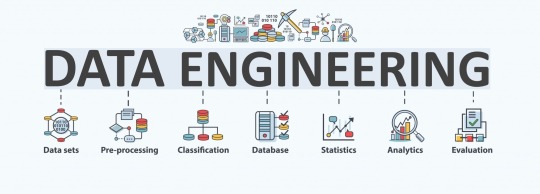
In the era of big data, the ability to design, build, and manage scalable data infrastructure is one of the most in-demand skills in the tech industry. At SEEREE, we are proud to offer a comprehensive Data Engineering course that prepares you for a career at the forefront of data-driven innovation.
Our program covers essential topics such as data modeling, ETL processes, data warehousing, cloud platforms, and tools like Apache Spark, Kafka, and Hadoop. You’ll learn how to collect, organize, and transform raw data into actionable insights, enabling businesses to make smarter decisions.
With real-world projects, expert mentorship, and hands-on experience with the latest technologies, we ensure that you are industry-ready. Whether you’re starting fresh or upskilling, this program will empower you to unlock opportunities in the rapidly growing field of data engineering.
Join SEEREE Institute and take the first step toward building the data pipelines that power tomorrow’s technology!"
Course13:- PGDCA

Seeree offers the best MERN course in Bhubaneswar with 100% job assurance and low fees. Learn from real-time corporate trainers and experienced faculty. Seeree helps students build confidence and gain skills to excel in company roles.
In today’s digital age, computer applications are at the heart of every industry, driving innovation and efficiency. At SEEREE Institute, our Post Graduate Diploma in Computer Applications (PGDCA) program is designed to provide you with in-depth knowledge and hands-on skills to excel in the IT world.
This program offers a comprehensive curriculum covering programming languages, database management, web development, software engineering, networking, and more. Whether you aim to enhance your technical expertise or step into a rewarding career in IT, PGDCA at SEEREE equips you with the tools to succeed.
With expert faculty, state-of-the-art labs, and real-world projects, we ensure that you gain practical experience and a strong theoretical foundation. By the end of the program, you’ll be prepared for roles such as software developer, system analyst, IT manager, or database administrator.
Course14:- Tally

Seeree offers the best Tally course in Bhubaneswar with 100% job assurance and low fees. Learn from real-time corporate trainers and experienced faculty. Seeree helps students build confidence and gain skills to excel in company roles.
In today’s business world, efficient financial management is key to success, and Tally is one of the most trusted tools for accounting and financial operations. At SEEREE Institute, we offer a comprehensive Tally course designed to equip you with the skills needed to manage business finances effortlessly.
Our program covers everything from the basics of accounting and bookkeeping to advanced features like GST compliance, inventory management, payroll processing, and generating financial reports. With hands-on training and real-world applications, you’ll gain practical expertise in using Tally effectively for businesses of any scale.
Whether you're a student, a professional, or a business owner, our Tally program is tailored to meet your needs and enhance your career prospects in the fields of accounting and finance.
Course15:- Graphics Design

In the world of creativity and communication, graphic design plays a vital role in bringing ideas to life. At SEEREE Institute, our Graphic Design course is tailored to help you unlock your creative potential and master the art of visual storytelling.
Our program covers a wide range of topics, including design principles, color theory, typography, branding, and user interface design. You’ll gain hands-on experience with industry-standard tools like Adobe Photoshop, Illustrator, and InDesign, enabling you to create stunning visuals for print, digital media, and beyond.
Whether you're an aspiring designer or a professional looking to sharpen your skills, our expert trainers and real-world projects will provide you with the knowledge and confidence to excel in this competitive field.
Join SEEREE Institute and start your journey toward becoming a skilled graphic designer. Let’s design your future together!"
2 notes
·
View notes
Text
java full stack
A Java Full Stack Developer is proficient in both front-end and back-end development, using Java for server-side (backend) programming. Here's a comprehensive guide to becoming a Java Full Stack Developer:
1. Core Java
Fundamentals: Object-Oriented Programming, Data Types, Variables, Arrays, Operators, Control Statements.
Advanced Topics: Exception Handling, Collections Framework, Streams, Lambda Expressions, Multithreading.
2. Front-End Development
HTML: Structure of web pages, Semantic HTML.
CSS: Styling, Flexbox, Grid, Responsive Design.
JavaScript: ES6+, DOM Manipulation, Fetch API, Event Handling.
Frameworks/Libraries:
React: Components, State, Props, Hooks, Context API, Router.
Angular: Modules, Components, Services, Directives, Dependency Injection.
Vue.js: Directives, Components, Vue Router, Vuex for state management.
3. Back-End Development
Java Frameworks:
Spring: Core, Boot, MVC, Data JPA, Security, Rest.
Hibernate: ORM (Object-Relational Mapping) framework.
Building REST APIs: Using Spring Boot to build scalable and maintainable REST APIs.
4. Database Management
SQL Databases: MySQL, PostgreSQL (CRUD operations, Joins, Indexing).
NoSQL Databases: MongoDB (CRUD operations, Aggregation).
5. Version Control/Git
Basic Git commands: clone, pull, push, commit, branch, merge.
Platforms: GitHub, GitLab, Bitbucket.
6. Build Tools
Maven: Dependency management, Project building.
Gradle: Advanced build tool with Groovy-based DSL.
7. Testing
Unit Testing: JUnit, Mockito.
Integration Testing: Using Spring Test.
8. DevOps (Optional but beneficial)
Containerization: Docker (Creating, managing containers).
CI/CD: Jenkins, GitHub Actions.
Cloud Services: AWS, Azure (Basics of deployment).
9. Soft Skills
Problem-Solving: Algorithms and Data Structures.
Communication: Working in teams, Agile/Scrum methodologies.
Project Management: Basic understanding of managing projects and tasks.
Learning Path
Start with Core Java: Master the basics before moving to advanced concepts.
Learn Front-End Basics: HTML, CSS, JavaScript.
Move to Frameworks: Choose one front-end framework (React/Angular/Vue.js).
Back-End Development: Dive into Spring and Hibernate.
Database Knowledge: Learn both SQL and NoSQL databases.
Version Control: Get comfortable with Git.
Testing and DevOps: Understand the basics of testing and deployment.
Resources
Books:
Effective Java by Joshua Bloch.
Java: The Complete Reference by Herbert Schildt.
Head First Java by Kathy Sierra & Bert Bates.
Online Courses:
Coursera, Udemy, Pluralsight (Java, Spring, React/Angular/Vue.js).
FreeCodeCamp, Codecademy (HTML, CSS, JavaScript).
Documentation:
Official documentation for Java, Spring, React, Angular, and Vue.js.
Community and Practice
GitHub: Explore open-source projects.
Stack Overflow: Participate in discussions and problem-solving.
Coding Challenges: LeetCode, HackerRank, CodeWars for practice.
By mastering these areas, you'll be well-equipped to handle the diverse responsibilities of a Java Full Stack Developer.
visit https://www.izeoninnovative.com/izeon/
2 notes
·
View notes
Text
From Beginner to Pro: Dominate Automated Testing with Our Selenium Course
Welcome to our comprehensive Selenium course designed to help individuals from all backgrounds, whether novice or experienced, enhance their automated testing skills and become proficient in Selenium. In this article, we will delve into the world of Selenium, an open-source automated testing framework that has revolutionized software testing. With our course, we aim to empower aspiring professionals with the knowledge and techniques necessary to excel in the field of automated testing.

Why Choose Selenium?
Selenium offers a wide array of features and capabilities that make it the go-to choice for automated testing in the IT industry.
It allows testers to write test scripts in multiple programming languages, including Java, Python, C#, and more, ensuring flexibility and compatibility with various project requirements.
Selenium’s compatibility with different web browsers such as Chrome, Firefox, Safari, and Internet Explorer makes it a versatile choice for testing web applications.
The ability to leverage Selenium WebDriver, which provides a simple and powerful API, allows for seamless interaction with web elements, making automating tasks easier than ever before.
Selenium’s Key Components:
Selenium IDE:
Selenium Integrated Development Environment (IDE) is a Firefox plugin primarily used for recording and playing back test cases. It offers a user-friendly interface, allowing even non-programmers to create basic tests effortlessly.
Although Selenium IDE is a valuable tool for beginners, our course primarily focuses on Selenium WebDriver due to its advanced capabilities and wider scope.
Selenium WebDriver:
Selenium WebDriver is the most critical component of the Selenium framework. It provides a programming interface to interact with web elements and perform actions programmatically.
WebDriver’s functionality extends beyond just browser automation; it also enables testers to handle alerts, pop-ups, frames, and handle various other web application interactions.
Our Selenium course places significant emphasis on WebDriver, equipping learners with the skills to automate complex test scenarios efficiently.
Selenium Grid:
Selenium Grid empowers testers by allowing them to execute tests on multiple machines and browsers simultaneously, making it an essential component for testing scalability and cross-browser compatibility.
Through our Selenium course, you’ll gain a deep understanding of Selenium Grid and learn how to harness its capabilities effectively.
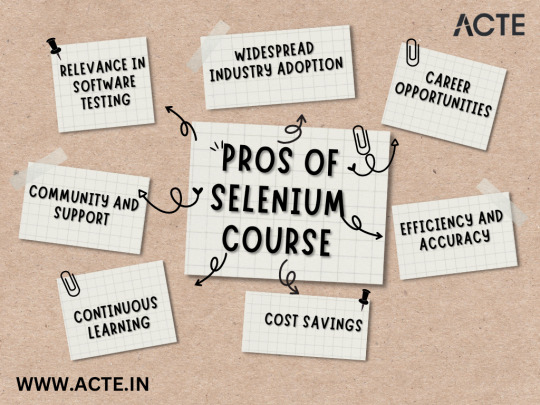
The Benefits of Our Selenium Course
Comprehensive Curriculum: Our course is designed to cover everything from the fundamentals of automated testing to advanced techniques in Selenium, ensuring learners receive a well-rounded education.
Hands-on Experience: Practical exercises and real-world examples are incorporated to provide learners with the opportunity to apply their knowledge in a realistic setting.
Expert Instruction: You’ll be guided by experienced instructors who have a profound understanding of Selenium and its application in the industry, ensuring you receive the best possible education.
Flexibility: Our course offers flexible learning options, allowing you to study at your own pace and convenience, ensuring a stress-free learning experience.
Industry Recognition: Completion of our Selenium course will provide you with a valuable certification recognized by employers worldwide, enhancing your career prospects within the IT industry.
Who Should Enroll?
Novice Testers: If you’re new to the world of automated testing and aspire to become proficient in Selenium, our course is designed specifically for you. We’ll lay a strong foundation and gradually guide you towards becoming a pro in Selenium automation.
Experienced Testers: Even if you already have experience in automated testing, our course will help you enhance your skills and keep up with the latest trends and best practices in Selenium.
IT Professionals: Individuals working in the IT industry, such as developers or quality assurance engineers, who want to broaden their skillset and optimize their testing processes, will greatly benefit from our Selenium course.
In conclusion, our Selenium course is a one-stop solution for individuals seeking to dominate automated testing and excel in their careers. With a comprehensive curriculum, hands-on experience, expert instruction, and industry recognition, you’ll be well-prepared to tackle any automated testing challenges that come your way. Make the smart choice and enroll in our Selenium course at ACTE Technologies today to unlock your full potential in the world of software testing.
7 notes
·
View notes
Text
My open-source decentralized core
I asked before if people would love to hear about my open-source projects, and I got a lot of really great responses, so here we go...
About the project
I've been working on a NodeJS project lately, it's a decentralized real-time data network integrated with AI policies and other cool security features, It's only been a few weeks under development and in its early stages, but I hope we get somewhere with it.
The project is called ddeep-core, and it's supposed to be a tool under the ddeep ecosystem we are building in Multi Neon (my startup).
This core is supposed to be a more secure way to sync, save, and process decentralized graph data in real time based on data subscriptions and policies.
link to the project
How it works
First of all, a peer (device or browser) would subscribe to some data (a node in the graph database) by opening a connection with the core and sending a get message, and if the policies applied to that node are satisfied, it will add a real-time listener to that node and send back the current node's data, otherwise, it just ignores it.
Now every time someone updates that node's data by sending a put message, that peer will receive a real-time update.
well, these policies can be AI-powered... so for example, if you want to prevent any angry inputs from being added to the network under the 'posts' node, you can do so in 3 lines of code easily.
ddeep-core can be a fully decentralized solution, and if you want to save data to storage, you can do that too with features like recovery checkpoints...
It supports IP whitelisting to prevent cross-site attacks and that kind of stuff, It manages the data well by resetting the graph and listeners every while, and with each peer connection close.
There is no API for this yet, but it works perfectly with Gun.js or just by sending requests to it, we are currently working on an interface API to communicate with the core in a more efficient way.
So, is it good ??
So far the results are pretty good, if we are talking about stability we still have a long road to go with more testing, and if we are talking about performance, It's good so far.
ddeep-core is good when it comes to performance, as it ignores a lot of things when processing connections and messages, for example, if the core has to deal with a put request, and has to save data to storage too, it won't wait for the saving process to finish, it will just ignore if it's done or not and send the updated data to all peers listening to it (after processing the policies for sure).
I focused a lot on the data structure of listeners and peers, and I hope I got it well as it really affects the performance a lot.
#technology#software engineering#coding#decentralization#software#open source#programming#artificial intelligence#backend
4 notes
·
View notes
Text
The Potential of Selenium: A Comprehensive Guide to Certification Training
In the ever-evolving landscape of software development, the significance of robust testing methodologies cannot be overstated. Selenium, an open-source automation testing tool, has emerged as a cornerstone in the pursuit of efficient and effective web application testing. Selenium testing certification training is a structured program designed to empower individuals with the skills and knowledge needed to harness the full potential of Selenium. Embracing Selenium's capabilities becomes even more accessible and impactful with Selenium Training in Hyderabad. This training equips individuals with the skills and knowledge to harness the full potential of Selenium, enabling them to proficiently navigate web automation challenges and contribute effectively to their respective fields. This comprehensive guide delves into the intricacies of Selenium, the key components covered in certification training, and the transformative impact it can have on one's career in software testing.

The Power of Selenium in Software Testing:
Selenium has become synonymous with automation testing, offering a versatile and powerful solution for testing web applications. Its open-source nature, coupled with a vibrant community, has made it the go-to choice for testers aiming to streamline repetitive tasks and ensure the robustness of web applications. Selenium testing certification training is the gateway for individuals to master this tool and unlock its potential in the dynamic world of software testing.
Purposeful Focus on Web Application Testing:
At the heart of Selenium testing certification training is a laser-focused approach to web application testing. Participants embark on a journey to understand the nuances of Selenium, equipping themselves to efficiently test and validate web applications. The program's primary aim is to enable testers to perform tasks with precision, thereby enhancing the overall quality of web applications.
Deconstructing Selenium: Exploring Its Key Components:
The training program systematically guides participants through the various components of Selenium. From Selenium WebDriver, which provides a powerful API for browser automation, to Selenium Grid, facilitating parallel test execution, participants gain a comprehensive understanding of Selenium's features and capabilities. This deconstruction of Selenium's components lays the foundation for participants to navigate the tool effectively and strategically apply it in diverse testing scenarios. To unlock the full potential of Selenium and master the art of web automation, consider enrolling in the Top Selenium Training Institute.
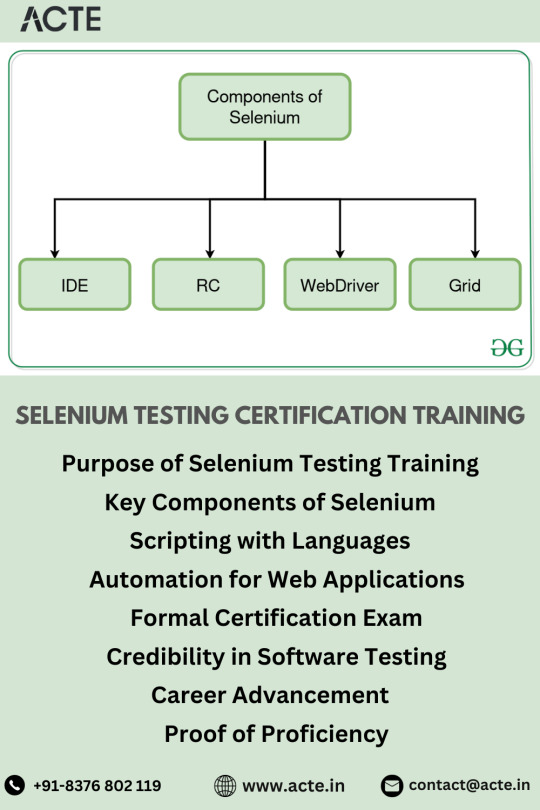
Scripting Mastery with Java or Python:
An integral part of Selenium testing certification training is the mastery of scripting languages. Participants are immersed in the intricacies of scripting with languages like Java or Python, essential for creating robust automation scripts. This hands-on experience empowers testers to articulate their testing scenarios in code, a fundamental skill that enhances the adaptability and scalability of their testing efforts.
Formal Certification Exam: A Culmination of Learning:
The journey through Selenium testing certification training culminates in a formal certification exam. This examination serves as a comprehensive evaluation of participants' knowledge and practical skills in utilizing Selenium for web testing. Successfully navigating this assessment not only validates the individual's proficiency but also provides a tangible testament to their commitment to excellence in software testing.
Elevating Credibility in Software Testing:
Completion of the training and the subsequent acquisition of certification elevate an individual's credibility in the field of software testing. Employers and industry peers recognize the value of a Selenium certification as a mark of proficiency and commitment to staying at the forefront of testing methodologies. This newfound credibility opens doors to opportunities for growth and advancement in the software testing domain.
A Catalyst for Career Advancement:
Armed with Selenium certification, individuals position themselves as valuable assets in the competitive landscape of quality assurance and automation testing. The certification serves as a catalyst for career advancement, providing a distinct advantage in job applications and promotions. Employers increasingly seek professionals with practical, hands-on experience in Selenium, making the certification a strategic asset for those aspiring to climb the career ladder in software testing.
Tangible Proof of Proficiency:
The significance of passing the certification exam goes beyond a mere acknowledgment—it serves as tangible proof of proficiency. Employers can trust that a certified individual possesses the necessary skills to leverage Selenium effectively in a testing environment. This proof of proficiency instills confidence in the individual and their ability to contribute meaningfully to the testing processes within their organization.
Embracing Selenium Testing Certification Training: A Journey of Transformation:
In essence, Selenium testing certification training is more than just a program—it's a transformative journey. It equips individuals with the knowledge and skills to not only navigate Selenium for web testing but also to excel in the ever-evolving landscape of software testing. The certification becomes a badge of honor, a testament to one's commitment to continuous learning and excellence in the field.
Aspiring and seasoned software testers alike can benefit immensely from Selenium testing certification training. The structured curriculum, hands-on experience, and formal certification process combine to create a holistic learning experience. The journey unlocks the potential of Selenium, propelling individuals toward a future where they can confidently and competently contribute to the quality assurance and testing processes of any organization. Embark on this journey, embrace the transformation, and position yourself at the forefront of software testing excellence. Happy testing!
2 notes
·
View notes
Text
Build Your Healthtech MVP Now: AI Record Summarizer in 30 Days
Limited to 3 buyers at this price. Exclusivity option: Add $3,000. Page retires after 3 sales.
💡 The Idea
Healthcare Record Summarizer is a game-changer for healthtech startups! This AI app transforms bulky medical records into concise summaries, saving clinicians time and speeding up patient care. No more drowning in paperwork — this MVP delivers clear insights and syncs with hospital systems. It’s a scalable SaaS ready to license to clinics or pitch to VCs, tapping a massive market gap.
📦 What You’ll Get
✅ AI-Powered Summarization
Condenses 100+ page records into clear, actionable summaries with smart AI.
✅ Patient-Friendly Summaries
Sends easy-to-read reports to patients via email or PDF.
✅ Web + Mobile App
Intuitive interface for clinicians to review and edit summaries.
✅ EHR Integration Ready
Connects to Epic via API for seamless record access.
✅ Healthcare-Grade Security
Encrypted data, HIPAA-compliant for patient trust.
✅ Cloud Deployment Blueprint
Scalable AWS setup for hospital-scale traffic.
✅ Future Roadmap Document
A plan to scale with analytics and multi-EHR support.
What’s Excluded
Non-Epic integrations (available in full build).
On-premise hosting (cloud-only in pilot).
Predictive analytics (included in roadmap).
Ongoing support beyond handoff (optional add-on).
📋 What You Need to Provide
Epic API Access: Provide credentials or API key at project start for integration.
AWS Account: Your active AWS account for hosting (we’ll handle setup).
No other dependencies — our AI uses open-source tools for summarization.
🗓 Timeline
✅ MVP Delivery: 30 Days
Planning + Setup: 3 days
AI Summarization Pipeline: 8 days
Frontend Interface: 8 days
Integration & Security: 7 days
Testing & Deployment: 4 days
Total: ~220 hours, 3 engineers
💰 Price
$9,999
Exclusivity: Add $3,000 for sole ownership, or keep non-exclusive to save.
✔ Complete MVP with codebase, documentation, and future roadmap
✔ Full tech handoff or optional continued development
✔ 30-day delivery, under NDA
✔ No hidden costs
✔ Option to scale into a full product
After You Buy
Once you claim Healthcare Record Summarizer:
Limited to 3 buyers; page retires after third sale or exclusivity purchase.
Our MVP team calls you within 12 hours to start.
Work begins on your timeline, as fast as same-day.
Why It’s Valuable
Market Gap: Bulky records delay care — this MVP saves hours and lives.
VC Magnet: Healthtech is investor gold — pitch this for massive funding.
First-Mover Edge: Launch a game-changer in 30 days.
Revenue Potential: License to hospitals or build a subscription model.
Proven Speed: Built by our 150+ AI experts with 100+ projects and 98% client satisfaction.
🚀 Ready to Build Healthcare Record Summarizer?
Forget freelancers or slow agencies. Get a production-ready AI MVP in 30 days, built for healthcare success. Book a free 30-minute strategy call to secure one of 3 slots or pitch your own idea. Act fast — slots won’t last!
Claim Your MVP | Get a Free Consultation
Pricing is an estimate. Final costs confirmed during your free consultation.
0 notes
Text
api testing tools
Searching for reliable API testing tools? There are several excellent options to streamline your testing process. Karate offers a powerful open-source framework with a simple DSL, ideal for automating API tests, including performance and mock testing, and seamlessly integrates with CI/CD pipelines. REST-Assured is a great choice for Java developers, providing easy-to-use syntax for testing REST APIs. Postman remains a popular tool, allowing both manual and automated testing with scriptable workflows.
0 notes
Text
Why Choose CakePHP Development Services for Your Next Web Project?

When it comes to choosing the proper framework for your web project, you have come across a sea of options. But there is one that has stood the test of time: CakePHP. Whether you are building a simple website or a complex web application, CakePHP development services offer a balance of power, simplicity, and flexibility. It has been around for over a decade, and it is a favourite for businesses looking for fast, secure, and scalable solutions. Why should you consider CakePHP development services for your next project? Let us dive into what makes CakePHP the go-to framework for many developers and businesses.
What is CakePHP, and Why is it Popular?
CakePHP is an open-source PHP framework that is known for its simplicity and efficiency. CakePHP is based on the Model-View-Controller (MVC) architecture, which simplifies code organization in contrast to many other frameworks that call for intricate setups.
Over the years, CakePHP has gained trust due to its flexibility, security features, and rich community support. Developers that need to quickly create dynamic, database-backed websites and applications without sacrificing quality frequently use it.
However, it goes beyond the rate of development. The framework is a dependable option for lengthy projects because of its vibrant community, which guarantees regular updates, security patches, and an abundance of resources.
Key Features of CakePHP Development Services.
By selecting CakePHP development services, you are selecting a framework that offers a number of features intended to simplify the lives of developers and companies alike.
First of all, the framework's integrated Object-Relational Mapping (ORM) makes database interactions more efficient and seamless by minimizing the need for repetitive scripting.
Another important feature of CakePHP is the rapid development tools that come with it. Its code generation and scaffolding capabilities enable developers to quickly build the foundational architecture of an application or website. Businesses will see reduced expenses and quicker response times as a result.
Security is always a concern when developing websites, and CakePHP development services tackle this by providing built-in protection against common vulnerabilities like SQL injection and cross-site scripting (XSS). With these features out of the box, you don’t need to spend time worrying about security flaws.
CakePHP and Website Development Services: A Perfect Match
Why are CakePHP development services often chosen for complex website development services? It is simple—CakePHP allows developers to create highly scalable, customizable websites that are easy to maintain. Whether you are building a blog, an eCommerce site, or a custom web application, CakePHP’s flexibility makes it adaptable to any project.
Additionally, the framework easily interfaces with third-party services and APIs, which is essential if you want to increase the functionality of your website without starting from scratch. Do you want to include a social media feed, an analytics tool, or a payment gateway? This is made simple using CakePHP development services.
CakePHP makes it possible for companies who want to grow gradually. You can start small with basic functionality and easily add features as your business grows.
How CakePHP Development Services Benefit Your Business
CakePHP development services are not just about building websites—they are about creating solutions that work for your business.
One of the significant benefits of using CakePHP is its rapid development cycle. It gives businesses a competitive edge by accelerating their time to market. CakePHP's simplified development tools enable quicker prototyping and iteration, which is crucial in today's fast-paced digital environment, rather than waiting months for a project to launch.
Since CakePHP development services reduce the amount of custom coding needed, they cut down on development time and expenses. This makes CakePHP an excellent option for startups and small businesses that want to deliver a top-tier web solution without breaking the bank.
Real-World Applications of CakePHP.
From simple websites to enterprise-level applications, CakePHP has been used across various industries to build robust digital solutions. CakePHP, for instance, is used by companies in the eCommerce industry to create online stores that manage thousands of transactions daily while guaranteeing a flawless user experience.
In the same way, CakePHP is used to build reliable online applications that securely and effectively handle data in the fields of education and healthcare. The flexibility of the framework allows businesses to build custom features based on their specific needs while still maintaining the reliability and performance they require.
If you are looking to develop a web application that needs to handle data or interact with external systems, CakePHP development services are a perfect fit.
Why Choose CakePHP Development Services for Your Next Project?
If you are still on the fence about CakePHP, here is a key reason why it stands out: it is built for developers and businesses who want more than just a basic website.
With CakePHP development services, you get the right mix of functionality, speed, and security—without the heavy lifting. Whether you are creating a business site, a content management system (CMS), or an eCommerce platform, CakePHP provides the tools and flexibility to bring your project to life.
Moreover, CakePHP has an active community of developers, so you can always rely on the support of others to overcome challenges. And with its proven track record, you can rest assured that you are choosing a framework that will continue to evolve and support your business as it grows.
Summing Up!
Choosing the proper framework for your website development project is no small decision.
But when you opt for CakePHP development services, you are choosing a framework that is trusted by developers and businesses alike. It provides scalability, security, quick development, and a multitude of tools to support your success.
Therefore, CakePHP is a strong tool that may assist you in reaching your objectives, whether you are starting a new project or making improvements to an existing one.
Ready to get started? Look no further than CakePHP development services to help you build the website of your dreams.
#CakePHP development services#CakePHP development services in india#Cakephp development company#Cakephp developer
0 notes
Text
In today’s digital world, injustice lurks in the shadows of the Facebook post that’s delivered to certain groups of people at the exclusion of others, the hidden algorithm used to profile candidates during job interviews, and the risk-assessment algorithms used for criminal sentencing and welfare fraud detention. As algorithmic systems are integrated into every aspect of society, regulatory mechanisms struggle to keep up.
Over the past decade, researchers and journalists have found ways to unveil and scrutinize these discriminatory systems, developing their own data collection tools. As the internet has moved from browsers to mobile apps, however, this crucial transparency is quickly disappearing.
Third-party analysis of digital systems has largely been made possible by two seemingly banal tools that are commonly used to inspect what’s happening on a webpage: browser add-ons and browser developer tools.
Browser add-ons are small programs that can be installed directly onto a web browser, allowing users to augment how they interact with a given website. While add-ons are commonly used to operate tools like password managers and ad-blockers, they are also incredibly useful for enabling people to collect their own data within a tech platform’s walled garden.
Similarly, browser developer tools were made to allow web developers to test and debug their websites’ user interfaces. As the internet evolved and websites became more complex, these tools evolved too, adding features like the ability to inspect and change source code, monitor network activity, and even detect when a website is accessing your location or microphone. These are powerful mechanisms for investigating how companies track, profile, and target their users.
I have put these tools to use as a data journalist to show how a marketing company logged users’ personal data even before they clicked “submit” on a form and, more recently, how the Meta Pixel tool (formerly the Facebook Pixel tool) tracks users without their explicit knowledge in sensitive places such as hospital websites, federal student loan applications, and the websites of tax-filing tools.
In addition to exposing surveillance, browser inspection tools provide a powerful way to crowdsource data to study discrimination, the spread of misinformation, and other types of harms tech companies cause or facilitate. But in spite of these tools’ powerful capabilities, their reach is limited. In 2023, Kepios reported that 92 percent of global users accessed the internet through their smartphones, whereas only 65 percent of global users did so using a desktop or laptop computer.
Though the vast majority of internet traffic has moved to smartphones, we don’t have tools for the smartphone ecosystem that afford the same level of “inspectability” as browser add-ons and developer tools. This is because web browsers are implicitly transparent, while mobile phone operating systems are not.
If you want to view a website in your web browser, the server has to send you the source code. Mobile apps, on the other hand, are compiled, executable files that you usually download from places such as Apple’s iOS App Store or Google Play. App developers don’t need to publish the source code for people to use them.
Similarly, monitoring network traffic on web browsers is trivial. This technique is often more useful than inspecting source code to see what data a company is collecting on users. Want to know which companies a website shares your data with? You’ll want to monitor the network traffic, not inspect the source code. On smartphones, network monitoring is possible, but it usually requires the installation of root certificates that make users’ devices less secure and more vulnerable to man-in-the-middle attacks from bad actors. And these are just some of the differences that make collecting data securely from smartphones much harder than from browsers.
The need for independent collection is more pressing than ever. Previously, company-provided tools such as the Twitter API and Facebook’s CrowdTangle, a tool for monitoring what’s trending on Facebook, were the infrastructure that powered a large portion of research and reporting on social media. However, as these tools become less useful and accessible, new methods of independent data collection are needed to understand what these companies are doing and how people are using their platforms.
To meaningfully report on the impact digital systems have on society, we need to be able to observe what’s taking place on our devices without asking a company for permission. As someone who has spent the past decade building tools that crowdsource data to expose algorithmic harms, I believe the public should have the ability to peek under the hood of their mobile apps and smart devices, just as they can on their browsers. And it’s not just me: The Integrity Institute, a nonprofit working to protect the social internet, recently released a report that lays bare the importance of transparency as a lever to achieve public interest goals like accountability, collaboration, understanding, and trust.
To demand transparency from tech platforms, we need a platform-independent transparency framework, something that I like to call an inspectability API. Such a framework would empower even the most vulnerable populations to capture evidence of harm from their devices while minimizing the risk of their data being used in research or reporting without their consent.
An application programming interface (API) is a way for companies to make their services or data available to other developers. For example, if you’re building a mobile app and want to use the phone’s camera for a specific feature, you would use the iOS or Android Camera API. Another common example is an accessibility API, which allows developers to make their applications accessible to people with disabilities by making the user interface legible to screen readers and other accessibility tools commonly found on modern smartphones and computers. An inspectability API would allow individuals to export data from the apps they use every day and share it with researchers, journalists, and advocates in their communities. Companies could be required to implement this API to adhere to transparency best practices, much as they are required to implement accessibility features to make their apps and websites usable for people with disabilities.
In the US, residents of some states can request the data companies collect on them, thanks to state-level privacy laws. While these laws are well-intentioned, the data that companies share to comply with them is usually structured in a way that obfuscates crucial details that would expose harm. For example, Facebook has a fairly granular data export service that allows individuals to see, amongst other things, their “Off-Facebook activity.” However, as the Markup found during a series of investigations into the use of Pixel, even though Facebook told users which websites were sharing data, it did not reveal just how invasive the information being shared was. Doctor appointments, tax filing information, and student loan information were just some of the things that were being sent to Facebook. An inspectability API would make it easy for people to monitor their devices and see how the apps they use track them in real time.
Some promising work is already being done: Apple’s introduction of the App Privacy Report in iOS 15 marked the first time iPhone users could see detailed privacy information to understand each app’s data collection practices and even answer questions such as, “Is Instagram listening to my microphone?”
But we cannot rely on companies to do this at their discretion—we need a clear framework to define what sort of data should be inspectable and exportable by users, and we need regulation that penalizes companies for not implementing it. Such a framework would not only empower users to expose harms, but also ensure that their privacy is not violated. Individuals could choose what data to share, when, and with whom.
An inspectability API will empower individuals to fight for their rights by sharing the evidence of harm they have been exposed to with people who can raise public awareness and advocate for change. It would enable organizations such as Princeton’s Digital Witness Lab, which I cofounded and lead, to conduct data-driven investigations by collaborating closely with vulnerable communities, instead of relying on tech companies for access. This framework would allow researchers and others to conduct this work in a way that is safe, precise, and, most importantly, prioritizes the consent of the people being harmed.
11 notes
·
View notes
Text
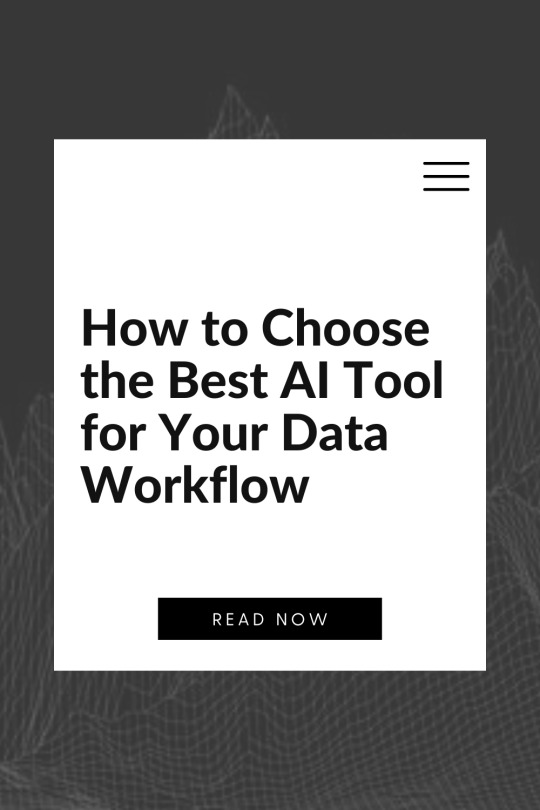
How to Choose the Best AI Tool for Your Data Workflow
AI isn’t just changing the way we work with data, it’s opening doors to entirely new possibilities. From streamlining everyday tasks to uncovering insights that were once out of reach, the right AI tools can make your data workflow smarter and more efficient. But with so many options out there, finding the one that fits can feel like searching for a needle in a haystack. That’s why taking the time to understand your needs and explore your options isn’t just smart, it’s essential.
In this guide, we’ll walk you through a proven, easy-to-remember decision-making framework: The D.A.T.A. Method: a 4-step process to help you confidently choose the AI tool that fits your workflow, team, and goals.

The D.A.T.A. Method: A Framework for Choosing AI Tools
The D.A.T.A. Method stands for:
Define your goals
Analyze your data needs
Test tools with real scenarios
Assess scalability and fit
Each step provides clarity and focus, helping you navigate a crowded market of AI platforms with confidence.
Step 1: Define Your Goals
Start by identifying the core problem you’re trying to solve. Without a clear purpose, it’s easy to be distracted by tools with impressive features but limited practical value for your needs.
Ask yourself:
What are you hoping to achieve with AI?
Are you focused on automating workflows, building predictive models, generating insights, or something else?
Who are the primary users: data scientists, analysts, or business stakeholders?
What decisions or processes will this tool support?
Having a well-defined objective will help narrow down your choices and align tool functionality with business impact.
Step 2: Analyze Your Data Needs
Different AI tools are designed for different types of data and use cases. Understanding the nature of your data is essential before selecting a platform.
Consider the following:
What types of data are you working with? (Structured, unstructured, text, image, time-series, etc.)
How is your data stored? (Cloud databases, spreadsheets, APIs, third-party platforms)
What is the size and volume of your data?
Do you need real-time processing capabilities, or is batch processing sufficient?
How clean or messy is your data?
For example, if you're analyzing large volumes of unstructured text data, an NLP-focused platform like MonkeyLearn or Hugging Face may be more appropriate than a traditional BI tool.
Step 3: Test Tools with Real Scenarios
Don’t rely solely on vendor claims or product demos. The best way to evaluate an AI tool is by putting it to work in your own environment.
Here’s how:
Use a free trial, sandbox environment, or open-source version of the tool.
Load a representative sample of your data.
Attempt a key task that reflects a typical use case in your workflow.
Assess the output, usability, and speed.
During testing, ask:
Is the setup process straightforward?
How intuitive is the user interface?
Can the tool deliver accurate, actionable results?
How easy is it to collaborate and share results?
This step ensures you're not just selecting a powerful tool, but one that your team can adopt and scale with minimal friction.
Step 4: Assess Scalability and Fit
Choosing a tool that meets your current needs is important, but so is planning for future growth. Consider how well a tool will scale with your team and data volume over time.
Evaluate:
Scalability: Can it handle larger datasets, more complex models, or multiple users?
Integration: Does it connect easily with your existing tech stack and data pipelines?
Collaboration: Can teams work together within the platform effectively?
Support: Is there a responsive support team, active user community, and comprehensive documentation?
Cost: Does the pricing model align with your budget and usage patterns?
A well-fitting AI tool should enhance (not hinder) your existing workflow and strategic roadmap.
“The best tools are the ones that solve real problems, not just the ones with the shiniest features.”
— Ben Lorica (Data scientist and AI conference organizer)
Categories of AI Tools to Explore
To help narrow your search, here’s an overview of AI tool categories commonly used in data workflows:
Data Preparation and Cleaning
Trifacta
Alteryx
DataRobot
Machine Learning Platforms
Google Cloud AI Platform
Azure ML Studio
H2O.ai
Business Intelligence and Visualization
Tableau – Enterprise-grade dashboards and visual analytics.
Power BI – Microsoft’s comprehensive business analytics suite.
ThoughtSpot – Search-driven analytics and natural language querying.
DataPeak by Factr – A next-generation AI assistant that’s ideal for teams looking to enhance decision-making with minimal manual querying.
AI Automation and Workflow Tools
UiPath
Automation Anywhere
Zapier (AI integrations)
Data Integration and ETL
Talend
Fivetran
Apache NiFi
Use the D.A.T.A. Method to determine which combination of these tools best supports your goals, data structure, and team workflows.
AI Tool Selection Checklist
Here’s a practical checklist to guide your evaluation process:
Have you clearly defined your use case and goals?
Do you understand your data’s structure, source, and quality?
Have you tested the tool with a real-world task?
Can the tool scale with your team and data needs?
Is the pricing model sustainable and aligned with your usage?
Does it integrate smoothly into your existing workflow?
Is support readily available?
Selecting the right AI tool is not about chasing the newest technology, it’s about aligning the tool with your specific needs, goals, and data ecosystem. The D.A.T.A. Method offers a simple, repeatable way to bring structure and strategy to your decision-making process.
With a thoughtful approach, you can cut through the noise, avoid common pitfalls, and choose a solution that genuinely enhances your workflow. The perfect AI tool isn’t the one with the most features, it’s the one that fits your needs today and grows with you tomorrow.
Learn more about DataPeak:
#datapeak#factr#saas#technology#agentic ai#artificial intelligence#machine learning#ai#ai-driven business solutions#machine learning for workflow#digitaltools#digital technology#digital trends#datadrivendecisions#dataanalytics#data driven decision making#agentic#ai solutions for data driven decision making#ai business tools#aiinnovation#ai platform for business process automation#ai business solutions
0 notes
Text
Selenium: The Cornerstone of Modern Web Automation Testing
In our increasingly digital world, websites are no longer just static information hubs. They are complex, interactive platforms powering essential services such as digital banking, e-learning, online shopping, and enterprise tools. As the role of web applications continues to expand, maintaining their reliability, efficiency, and intuitive design is more critical than ever. Whether managing a SaaS product or a dynamic e-commerce site, delivering a smooth user experience is inseparable from a robust and functional web interface.
Selenium: More Than Just a Single Tool
Selenium is often misunderstood as a standalone automation tool. In reality, it is a suite of specialized components, each addressing specific needs in browser-based automation. This flexibility allows teams to tailor their automation strategy according to their skill levels and project complexity.
The Selenium suite comprises:
Selenium IDE: A user-friendly browser extension for Chrome and Firefox that enables record-and-playback testing. It’s great for quick test creation, demos, or for those new to automation.
Selenium WebDriver: The core engine that offers direct interaction with web browsers through a rich API. It supports multiple languages and allows simulation of real-world user behavior with high precision.
Selenium Grid: Designed for distributed execution, it enables running tests in parallel across various browsers, operating systems, and machines, significantly reducing test duration and enhancing coverage.
This structure supports a progressive approach starting with simple test recordings and scaling up to advanced, enterprise-grade test frameworks. Enhance your web automation skills with our comprehensive Selenium Course Online, designed for beginners and professionals to master real-time testing techniques.

What Sets Selenium Apart in the Automation Landscape
Selenium remains a top choice among automation frameworks due to its open-source nature, adaptability, and strong community support. Its compatibility with several programming languages including Java, Python, JavaScript, and C# makes it highly versatile.
Notable strengths of Selenium include:
Cross-browser compatibility (Chrome, Firefox, Safari, Edge, etc.)
Cross-platform support for Windows, macOS, and Linux
Integration readiness with DevOps tools like Maven, Jenkins, Docker, and CI/CD pipelines
Large and active community, ensuring continuous enhancements and robust documentation
These features make Selenium an ideal solution for Agile and DevOps-driven environments where flexibility and scalability are essential.
Selenium WebDriver: The Automation Power Core
Selenium WebDriver is the most powerful and widely used component of the suite. It communicates directly with browsers using their native automation APIs, which leads to faster execution and more stable tests.
With WebDriver, testers can:
Simulate user actions such as clicking, typing, scrolling, and navigation
Interact with dynamic content and complex UI elements
Handle browser alerts, multiple tabs, and asynchronous behaviors
Use sophisticated waiting strategies to reduce flakiness
Its language flexibility and ease of integration with popular testing frameworks make it suitable for both functional and regression testing in modern applications.
Selenium Grid: For Fast, Parallel, and Scalable Testing
As projects grow in scale and complexity, running tests sequentially becomes impractical. Selenium Grid addresses this by supporting parallel test execution across different systems and environments.
Here’s how it works:
A central Hub routes test commands to multiple Nodes, each configured with specific browser and OS combinations.
Tests are automatically matched with suitable Nodes based on the desired configuration.
This setup enables:
Faster test cycles through concurrency
Expanded test coverage across platforms and browsers
Seamless scalability when integrated with Docker or cloud environments
Selenium Grid is particularly beneficial for CI/CD pipelines, enabling frequent and reliable testing in short time frames.
Challenges in Selenium and How to Overcome Them
Despite its many advantages, Selenium presents a few challenges. Fortunately, these can be addressed effectively with best practices and complementary tools.
1. Test Instability
Tests may fail unpredictably due to timing issues or dynamic content. Use robust locators, implement explicit or fluent waits, and add retry mechanisms where necessary.
2. High Maintenance Overhead
Frequent UI changes can break test scripts. Adopt the Page Object Model (POM), centralize selectors, and design modular, reusable components.
3. Lack of Native Reporting
Selenium does not include reporting features by default. Integrate reporting tools such as ExtentReports, Allure, or custom HTML reporters to visualize test outcomes and logs.
4. No Built-in Test Management
Selenium focuses on execution, not planning or tracking. Pair Selenium with test management tools like TestRail, Zephyr, or Jira plugins to organize and track testing efforts. Proactively addressing these issues leads to more reliable, maintainable, and scalable automation frameworks. Kickstart your career with our Best Training & Placement Program, offering expert-led sessions and guaranteed job support for a successful future in tech.

Selenium’s Strategic Role in Modern QA
As the software industry embraces continuous integration and delivery, quality assurance is shifting earlier in the development lifecycle, a practice known as Shift Left. Selenium supports this transition by enabling early and continuous automation.
Key benefits in modern workflows include:
Integration with CI tools like Jenkins, GitHub Actions, or Azure DevOps
Easy version control and code collaboration via Git
Support for data-driven testing, allowing validation of multiple scenarios using external data sources
This makes Selenium not just a testing tool, but a strategic partner in achieving high-quality, fast-paced software releases.
Conclusion
Selenium continues to play a crucial role in modern web automation. Its blend of flexibility, scalability, and open-source accessibility makes it a go-to framework for both startups and large enterprises. Whether you are verifying basic functionalities or managing a complex automation suite, Selenium equips you with the tools to build efficient and dependable tests. By following best practices such as structured test architecture, modular design, and integrated reporting Selenium can elevate your quality assurance efforts into a long-term strategic asset. As web technologies evolve and user expectations rise, Selenium will remain at the forefront of automated testing solutions.
0 notes
Text
Navigating the Pros and Cons of Selenium for Web Application Testing
Introduction: In the dynamic world of software development, automated testing is a cornerstone of ensuring product quality and reliability. Among the myriad of tools available for automated testing, Selenium stands out as a leading choice for testing web applications. In this comprehensive exploration, we'll dissect the advantages and disadvantages of Selenium, providing insights to aid in your decision-making process when selecting a testing tool.

Advantages of Selenium:
Cross-Browser Compatibility: Selenium boasts seamless compatibility across various web browsers, including Chrome, Firefox, Safari, and Internet Explorer. This ensures consistent performance and functionality across diverse platforms, enhancing the overall user experience.
Open-Source Foundation: Selenium's open-source nature not only makes it freely accessible but also fosters a collaborative community of developers. This community-driven approach facilitates continuous improvement and innovation, ensuring that Selenium remains at the forefront of automated testing technology.
Flexibility in Language Support: Selenium supports multiple programming languages, such as Java, Python, C#, Ruby, and JavaScript. This versatility empowers testers to leverage their language of choice, enhancing productivity and enabling seamless integration with existing workflows.
Integration with Testing Frameworks: Selenium seamlessly integrates with popular testing frameworks like TestNG, JUnit, and NUnit. This integration enhances test management capabilities and facilitates streamlined reporting, enabling efficient tracking of test results and issues.
Robust WebDriver API: Selenium's WebDriver API offers a robust and intuitive interface for automating web interactions. Testers can easily create and maintain test scripts, streamlining the testing process and minimizing manual effort.
Parallel Testing Capabilities: Selenium Grid enables parallel execution of tests across multiple browsers and environments. This parallel testing capability accelerates test execution, reduces time-to-market, and enhances test coverage, ultimately improving overall testing efficiency.
Extensive Ecosystem of Tools and Plugins: Selenium boasts an extensive ecosystem of tools and plugins that extend its functionality. From Selenium IDE for record-and-playback functionality to Selenium WebDriver for programmatic test automation, testers have access to a diverse range of tools to meet their specific testing needs.
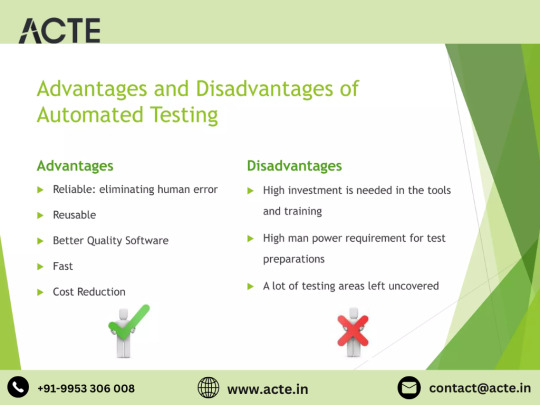
Disadvantages of Selenium:
Limited Support for Desktop and Mobile Applications: Selenium primarily focuses on web application testing and may lack robust support for testing desktop and mobile applications. Testers may need to explore additional tools and frameworks to achieve comprehensive test coverage across diverse platforms.
Steep Learning Curve: Selenium's rich feature set and versatility may present a steep learning curve, particularly for novice testers. Mastering Selenium's APIs and best practices may require significant time and effort, potentially delaying the adoption and implementation of automated testing.
Dependency on Browser Automation: Selenium's reliance on browser automation exposes test scripts to potential fragility and failures. Changes in browser versions or website structures may necessitate frequent updates and maintenance of test scripts to ensure their reliability and effectiveness.
Lack of Built-In Reporting: Selenium lacks built-in reporting capabilities, requiring testers to rely on third-party tools or custom scripts for generating comprehensive test reports. This additional overhead may increase the complexity and maintenance of test automation frameworks.
Limited Support for Non-Web Technologies: While Selenium excels in web application testing, it may offer limited support for testing non-web technologies such as APIs, databases, and mobile devices. Testers may need to supplement Selenium with additional tools and frameworks to achieve comprehensive test coverage across diverse technologies.
Resource Intensive Execution: Executing tests with Selenium, especially in parallel or on cloud-based Selenium Grids, may be resource-intensive. Testers must ensure adequate infrastructure and resources to support the scalability and performance requirements of their automated testing efforts.
Conclusion: In conclusion, Selenium emerges as a powerful tool for automated testing of web applications, offering numerous advantages such as cross-browser compatibility, open-source accessibility, and robust WebDriver API. However, it also presents certain challenges and limitations, including a steep learning curve, dependency on browser automation, and limited support for non-web technologies.
By carefully evaluating the pros and cons of Selenium and considering your specific testing requirements, you can make informed decisions about whether Selenium aligns with your automated testing needs. Ultimately, Selenium remains a top choice for testers seeking to ensure the quality and reliability of web applications in today's fast-paced development landscape.
3 notes
·
View notes